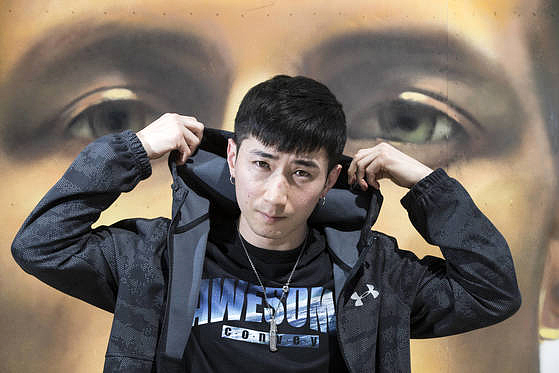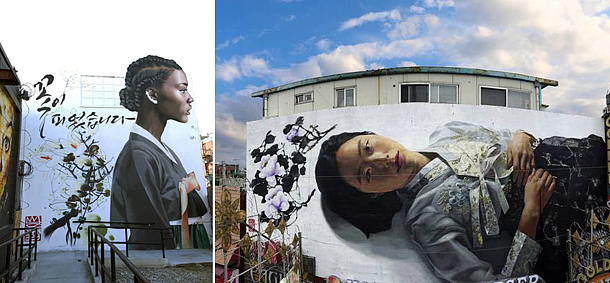Made in Korea, inspired by hip-hop : Shim Chan-yang shot to fame with his image of a black woman in hanbok

Shim Chan-yang [KWON HYUK-JAE]
The unconventional composite, made at the suggestion of Under Armour, is the work of artist Shim Chan-yang, who also goes by Chris and the pseudonym Royal Dog. His modus operandi, one he only recently developed, is adding Korean elements to his graffiti. Prior to the contracted piece for Under Armour, Shim participated in an urban regeneration project led by the Gyeonggi Museum of Art to create public art for the city of Dongducheon, about 24 miles north of Seoul. For his part, he drew a young woman in contemporized hanbok (traditional Korean clothing) on the exterior of a run-down shopping complex.
“Some people believe there is more value [to my graffiti] when it is in the realm of the arts,” Shim said, “but for me, just the fact that I can do graffiti and lead a hip-hop lifestyle is exciting and something that I am proud of.”
The graffiti artist has found much inspiration from the hip-hop culture that grew out of the African-American community during the 1980s and ‘90s, from the breakdancing of b-boys to the mixes produced by iconoclast DJs. Last year, Shim shot to fame when his images of a black woman dressed in hanbok and inscribed with Korean calligraphy popped up at the Container Yard in Los Angeles and a building in San Francisco. The juxtaposition of a black woman in braids with traditional Korean clothing generated praise for its fresh multicultural perspective.

Left: An image of a black woman in hanbok (traditional Korean clothing) produced by graffiti artist Shim Chang-yang adorns the wall of the Container Yard in Los Angeles. Right: As part of an urban regeneration project led by the Gyeonggi Museum of Art and city of Dongducheon, Shim tagged the exterior of a shopping complex with a picture of a woman in contemporized hanbok. [SHIM CHAN-YANG]
In middle school, Shim wanted to be a cartoonist. Late at night, while doing illustrations with the radio on, he discovered hip-hop, and the music opened him up to the world of graffiti. Before traveling to the United States, he lived in Australia for a year tagging walls. “I uploaded my resume and illustrations to a website, where I would receive inquiries like ‘draw one for my gym’ or ‘draw one in my garage,’” he recalled. “Australia was one of the top five countries in terms of graffiti. Even when they mistook me for a Chinese or young kid, when I illustrated for them, their perceptions changed.”
Naturally, his sojourn abroad would take him to the United States, the birthplace of graffiti. “I thought it was funny to call myself a graffiti artist without even visiting the Bronx or Brooklyn, the home of graffiti,” he said. Shim worked part-time jobs for two years to gather up the funds for his three-month trip to the States, during which he produced the famed black woman in hanbok.
With his newfound fame, Shim has more things to worry about. “Ever since being the talk of the town last year, I started thinking about my role [as a graffiti artist],” he said. “In Korea, the ingredients [for graffiti] are expensive and there aren’t enough walls to spray on.” Other than the “Apguree,” an underpass in Apgujeong-dong, southern Seoul, there are few places where graffiti artists can flaunt their talent.
While some people have argued for graffiti to be recognized as an art form, Shim believes the label comes with too much weight. “Part of me wants to say that this is art and that I am an artist, but honestly, it seems like too much of a big and elegant cloth for me,” he said. “It’s even on my Instagram profile ? ‘I am not an artist, I am a fan of hip-hop.’ Although these days, graffiti is up on galleries, the real appeal of graffiti lies in its untamed and rough nature. Artists rapidly paint it on walls, sign it and disappear. Even world-famous artists have been caught by law enforcement numerous times.”
In the future, Shim said he wants to draw for his fans and Instagram audience, which likely means more hanbok and other Korean elements on urban walls.
BY LEE HOO-NAM [kim.jungkyoon@joongang.co.kr]
그래피티 아티스트? 난 예술가 아닌 힙합 팬
“‘예술’이라고 불릴 때 더 가치가 있다고 생각하는 사람도 있지만 저한테는 힙합을 한다는 것, 그래피티를 한다는 것 자체가 굉장히 멋있고 뿌듯한 일이에요.”
그래피티 작가 심찬양(28)의 말이다. 그에게 듣자니 그래피티는 비보이의 춤, MC의 랩, DJ의 음악선곡·믹싱과 더불어 힙합의 4대 요소로 꼽힐만큼 불가분의 관계다. 힙합은 전세계에 유행하기에 앞서 1970년대말부터 미국, 특히 뉴욕의 흑인과 라틴계 청년들을 중심으로 발전한 문화다. 그렇게 탄생한 그래피티에 그는 한국적 요소를 대담하게 결합하며 곳곳에서 활약중이다. 미국 스포츠 브랜드 언더아머의 제안으로 최근 서울 강남역 부근 매장 내부에 선보인 그래피티는 농구 스타 스테판 커리, 이순신 장군, 거북선 등을 담았다. 얼마 전에는 경기도미술관과 동두천시가 도심재생을 위해 추진해온 공공미술 프로젝트에 참여, 동두천의 오래된 상가 건물 외벽에 요즘 분위기의 한복을 입은 젊은 여성을 그렸다.
그가 이처럼 한국적 요소를 그래피티에 담게 된 것은 사실 오래된 일이 아니다. 지난해 여름 뉴욕을 시작으로 미국 여러 도시에서 석 달 간 그래피티를 그려본 경험이 큰 계기가 됐다. 특히 LA와 샌프란시스코에서는 스트리트 아트 갤러리나 벽화축제가 제공한 벽에 검은 피부의 여성이 한복을 입은 모습을 그려 큰 호평을 받았다. 덩달아 한국에도 화제가 되고 그 역시 유명해졌다.
“처음에는 제가 그래피티를 하는 게 흑인이 판소리하는 것처럼 보일 수 있겠다고 생각했어요. 그 사람들은 40년 전부터 그래피티를 시작했으니까. 근데 자신들이 시작한 문화의 맛을 지구 반대편에서 가져온 사람을 보니까 감격하며 색다르다고 얘기하더라구요. 저도 고마웠죠. 나를 인정해주니까 한국적인 뭔가를 해도 되겠단 생각이 그 때부터 든 것 같아요. 한글을 조금씩 해보니 굉장히 멋있다고 해서 그럼, 한복 입은 걸 그려볼까 했죠.”
중학교 시절 그가 꿈꾸던 건 만화가였다. 밤늦도록 그림을 그리며 켜놓은 라디오 채널에서 한창 흘러나온 힙합이 그를 그래피티로 이끌었다. 아프리카에서 우물을 파는 선교사가 되려던 더 어렸을 때의 꿈 때문에 한때 신학을 공부하려 하기도 했지만 결국 그림을 선택했다. 미국에 앞서 호주에서도 1년 남짓 머물며 그래피티를 그렸다. “아르바이트 사이트에 그림을 올리면 연락이 와요. 체육관이나 자기 집에 그려달라고. 그래피티로는 세계 다섯 번째 안에 드는 나라에요. 저를 중국인이나 작은 어린애로 보다가 그림을 그리고 있으면 시선이 달라져요.” 그럴수록 본고장 미국에 가보고 싶은 마음도 컸던 모양이다. “뉴욕 브롱크스, 브루클린에서 시작된 문화인데 거길 안 가보고 그래피티를 하는 게 우습다고 생각했죠.” 호주에서 돌아온 직후부터 다양한 아르바이트로 2년 동안 돈을 모아 미국행 비행기에 오른 배경이다.
유명세를 타면서 요즘 그는 생각이 많아졌다. “지난해 갑자기 화제가 되면서 제 역할을 많이 생각해보게 됐어요. 이런 경우가 없었으니까. 한국은 재료도 비싸고 벽도 벽도 별로 없어요. 저한테 들어오는 제안을 잘 받아서 하면 벽도 많이 제공될 것 같고.” 국내에서 그래피티를 할 수 있는 곳은 일명 ‘압구리’로 불리는 서울 압구정동 굴다리 등을 제외하면 많지 않단다.
그래피티를 스트리트 아트의 하나로 보는 시각에 대해 그는 다른 생각을 들려줬다. 일단 재료의 차이부터 지적했다. “스트리트 아트는 붓으로, 스프레이로, 다양한 재료로 그리지만 그래피티는 스프레이로 그려요. 다른 걸 쓰면 좀 부끄러워하는 분위기죠.” 무엇보다 “그래피티는 좀 더 거칠고 길들여지지 않은 매력이 있다”고 했다. 요즘이야 미술관에서도 그래피티 전시가 열리곤 하지만 본래는 담벼락에 빠르게 그리고 서명을 남긴 뒤 사라지는 문화다. 세계적 작가들도 그래피티를 하다 경찰에 붙잡힌 경력이 한 두 번 아니다.
그는 “‘아트’란 말은 좀 낯간지러운 단어 같다”고 했다. “이건 예술이고 나는 예술가이고 그렇게 얘기하고 싶어하는 경우도 있지만 그게 저한테는 비싼 옷처럼 느껴져요. 인스타그램에 이렇게 적어놨어요. 나는 예술가 아니고 힙합 팬이라고.” 이후의 활동에 대해서는 “인스타그램 팔로워들이나 제 그림을 지켜보는 사람들이 기대하는 그림을 좀 더 해보고 싶다”고 했다. 한복 등 한국적 요소를 포함, 사실적인 그림을 가리키는 얘기다.
“원래 캐릭터 그리는 걸 좋아하는데 지금은 저만의 즐거움보다 남들에게 즐거움을 선사하는 길을 택하고 있는 거 같아요. 사진처럼 그리는 걸 사람들이 좋아하고 캐릭터 그리는 사람은 많은데 사진처럼 그리는 걸 잘하는 사람은 많지 않으니까.” ‘아프리카 우물파기’도 그에게는 여전히 유효한 꿈이다. "선교사로 돈을 지원받는 대신 제가 돈을 벌어 그런 일을 지원할 수도 있죠.”
이후남 기자










with the Korea JoongAng Daily
To write comments, please log in to one of the accounts.
Standards Board Policy (0/250자)